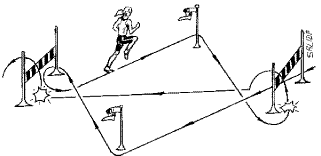- Individuales masculino
- Individual femenino
- Dobles masculino
- Dobles femenino
- Dobles mixto
A diferencia de otros deportes de raqueta, en bádminton no se juega con pelota, si no con un proyectil con plumas insertadas llamado volante o pluma.
Los jugadores deben golpear el volante con sus raquetas para que este cruce la pista sobre de la red y caiga en la de los oponentes. El punto finaliza cuando la pluma toca el suelo, y solo puede ser golpeada una vez antes de que pase por sobre la red.
Para un alto nivel de juego, este deporte requiere resistencia aeróbica, fuerza y velocidad. También es un deporte técnico, con alta exigencias de coordinación y habilidad con la raqueta.

Los postes tienen una altura de 1.55 metros, medidos desde el suelo de la pista. Se colocaran sobre las líneas laterales del campo de dobles.
La falta
Entre las más habituales y que deben conocerse para empezar a jugar cabe señalar:
Entre las más habituales y que deben conocerse para empezar a jugar cabe señalar:
- Golpear
el volante por encima de la cintura o que la cabeza de la raqueta está
por encima de la mano en el momento de golpear.
- Si
después del saque, el volante cae fuera de la zona de servicio contrario.
- Si en
el momento del servicio, el servidor o el que recibe, están fuera del área
que les corresponde.
- Si
durante el juego, el volante toca el suelo fuera de la superficie del
campo de juego o bien toca la vestimenta o parte del cuerpo de un jugador.
- Si se
golpea al volante en campo contrario o si durante el juego un jugador toca
la red o los postes.
- Si el
volante queda atrapado en la red o en la raqueta de un jugador o bien si
se golpea dos veces seguidas o arrastra el volante.
- Si un jugador hace una pantalla deliberada con la raqueta sobre la posición de golpeo del jugador contrario.
- El partido se jugará al mejor de 3 juegos.
- El lado que primero gane 21 puntos ganará un juego.
- El lado que consiga un tanto sumará un punto a su tanteo.
- Si en el tanteo se empata a 20, el lado que primero consiga alcanzar una diferencia de 2 puntos, ganará el juego.
- Si en el tanteo se empata a 29, el lado que consiga el punto número 30 ganará el juego.
- El lado que gane un juego sacará primero en el siguiente juego.
Respecto al cambio de lado:
Los jugadores deben cambiar de lado:
- Al final del primer juego.
- Antes de empezar el tercer juego (si existiera).
- En el tercer juego, cuando uno de los dos lados alcance 11 puntos.
Respecto al saque o servicio:
- El servidor y el receptor deben estar colocados dentro de los cuadros de saque diagonalmente opuestos.
- El volante deberá estar por debajo de la cintura del jugador en el instante de ser golpeado por la raqueta.
- Para que el saque sea válido el volante (si no es interceptado) debe caer en el cuadro de saque del receptor.
- Se sacará y se recibirá desde el cuadro derecho cuando el servidor no ha ganado ningún punto o ha conseguido un número de puntos par en el juego.
- Se sacará y se recibirá desde el cuadro izquierdo cuando el servidor ha conseguido un número de puntos impar en el juego.
- Saca el que gana el punto anterior.
- En el juego de dobles, el jugador del lado receptor que hubiera sacado el último debe permanecer en el cuadro de saque desde el que sacó. El patrón contrario será aplicado a su compañero. Además, los jugadores no cambiarán sus respectivos cuadros de saque hasta que ganen un punto teniendo ellos el servicio.
Los golpeos básicos:
Al hablar de la técnica del bádminton nos estamos refiriendo a los diferentes tipos de golpeos. Así pues, los tipos de golpeos son:
- Saque largo. Se utiliza principalmente en individuales.
- Saque de revés. Es propio de la modalidad de dobles.
- Clear. Se ejecuta desde el fondo de la pista por encima de la cabeza con el objetivo de que el volante llegue al fondo de la pista contraria.
- Drop. Es un golpe ofensivo que se ejecuta por encima de la cabeza con el objetivo de que el volante caiga justo detrás de la red.
- Lob. Es un golpe defensivo que se ejecuta cerca de la red por debajo de la cintura con el objetivo de que el volante llegue al fondo de la pista.
- Net drop (dejada). También se ejecuta cerca de la red.
- Drive. Es un golpe ofensivo que se ejecuta en el centro de la pista entre los hombros y la cintura. El volante sigue una trayectoria paralela al suelo.
- Smash. Es un golpe puramente ofensivo que se realiza por encima de la cabeza. Su trayectoria es claramente descendente.
Para comprender mejor los diferentes golpeos puedes ver el siguiente vídeo:
Para finalizar podéis ver algunos ejemplos de partidos en los que juegan profesionales.












